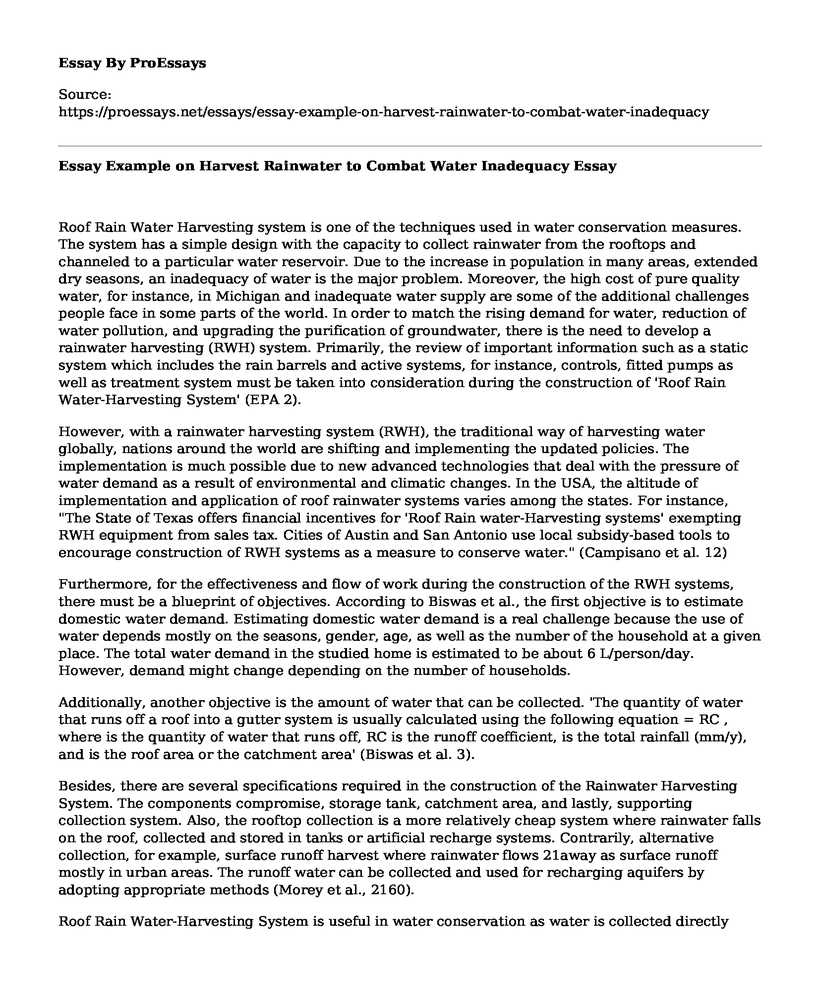Roof Rain Water Harvesting system is one of the techniques used in water conservation measures. The system has a simple design with the capacity to collect rainwater from the rooftops and channeled to a particular water reservoir. Due to the increase in population in many areas, extended dry seasons, an inadequacy of water is the major problem. Moreover, the high cost of pure quality water, for instance, in Michigan and inadequate water supply are some of the additional challenges people face in some parts of the world. In order to match the rising demand for water, reduction of water pollution, and upgrading the purification of groundwater, there is the need to develop a rainwater harvesting (RWH) system. Primarily, the review of important information such as a static system which includes the rain barrels and active systems, for instance, controls, fitted pumps as well as treatment system must be taken into consideration during the construction of 'Roof Rain Water-Harvesting System' (EPA 2).
However, with a rainwater harvesting system (RWH), the traditional way of harvesting water globally, nations around the world are shifting and implementing the updated policies. The implementation is much possible due to new advanced technologies that deal with the pressure of water demand as a result of environmental and climatic changes. In the USA, the altitude of implementation and application of roof rainwater systems varies among the states. For instance, "The State of Texas offers financial incentives for 'Roof Rain water-Harvesting systems' exempting RWH equipment from sales tax. Cities of Austin and San Antonio use local subsidy-based tools to encourage construction of RWH systems as a measure to conserve water." (Campisano et al. 12)
Furthermore, for the effectiveness and flow of work during the construction of the RWH systems, there must be a blueprint of objectives. According to Biswas et al., the first objective is to estimate domestic water demand. Estimating domestic water demand is a real challenge because the use of water depends mostly on the seasons, gender, age, as well as the number of the household at a given place. The total water demand in the studied home is estimated to be about 6 L/person/day. However, demand might change depending on the number of households.
Additionally, another objective is the amount of water that can be collected. 'The quantity of water that runs off a roof into a gutter system is usually calculated using the following equation = RC , where is the quantity of water that runs off, RC is the runoff coefficient, is the total rainfall (mm/y), and is the roof area or the catchment area' (Biswas et al. 3).
Besides, there are several specifications required in the construction of the Rainwater Harvesting System. The components compromise, storage tank, catchment area, and lastly, supporting collection system. Also, the rooftop collection is a more relatively cheap system where rainwater falls on the roof, collected and stored in tanks or artificial recharge systems. Contrarily, alternative collection, for example, surface runoff harvest where rainwater flows 21away as surface runoff mostly in urban areas. The runoff water can be collected and used for recharging aquifers by adopting appropriate methods (Morey et al., 2160).
Roof Rain Water-Harvesting System is useful in water conservation as water is collected directly from the rooftop and stored in an appropriate water reservoir for future use. The need for the system is to resolve the problem of water shortage resulting from a high population, prolonged dry seasons as well as the high cost of pure water. Implementation of new updated systems will improve the harvesting and proper storage of water. For the construction of the suitable RWH system, there should be productive objectives for sufficient water supply.
Works Cited
Biswas, Biplob K, and Bablu H. Mandal. "Construction and Evaluation of Rainwater Harvesting System for Domestic Use in a Remote and Rural Area of Khulna, Bangladesh." International Scholarly Research Notices. 2014 (2014): 1-6. Print.
Campisano, Alberto, et al. "Urban rainwater harvesting systems: research, implementation and future perspective." (2017): 1-41.
EPA. Rainwater Harvesting (2013): 1-36.
Morey, Aditya, et al. "International Research Journal of Engineering and Technology (IRJET)." RAINWATER HARVESTING SYSTEM (2016): 2158- 2161.
Cite this page
Essay Example on Harvest Rainwater to Combat Water Inadequacy. (2023, May 08). Retrieved from https://proessays.net/essays/essay-example-on-harvest-rainwater-to-combat-water-inadequacy
If you are the original author of this essay and no longer wish to have it published on the ProEssays website, please click below to request its removal:
- Essay on Water and Sewage Treatment
- The Effects of Global Warming on Biodiversity - Paper Example
- Essay Sample on Police Recruitment: High Potential Candidates Shut Out?
- Essay Sample on Katrina's Wrath: Unprecedented Destruction and Loss of Life
- Research Paper on Food Waste: A Major Contributor to Climate Change
- Climate Change: Defining Weather & Climate Patterns - Essay Sample
- Nature and Life: How Changing Nature Reflects Human Activities - Essay Sample







